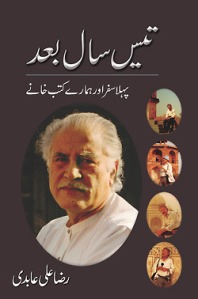It was a usual chilly December evening and fish eateries at Rawalpindi’s Committee Chowk were doing good business. Beyond the fish-vendors, most of the booksellers awaited customers. There, however, was hustle and bustle at a grand bookstore.
Located a few shops from the Committee Chowk, Ashraf Book Agency boasts the largest Urdu collection in the twin cities of Rawalpindi and Islamabad.
The main hall, behind-the-wall store rooms and the upper story are full with nothing other than Urdu fiction and non-fiction. The bookshop doesn’t trade in English books. It does not sell the low-quality — both in print and content — exam guides either, like many book shops in the area do. The owner Ijaz Ahmed says this is because of his love for Urdu language.
“My father ran Ashraf Library, an aana library, at the Committee Chowk and we have been running this bookstore for twenty years now,” he said. “Is your father alive?” “No,” came his reply. But his legacy remains, I thought to myself.
One enters the store and finds a whole wall of the Sang-e-Meel Publications‘ top selling authors: Mustansar Husain Tarar, Ashfaq Ahmed, Bano Qudsia, Dr Younas Butt, Manto, Amjad Islam Amjad, Raza Ali Abidi, Razia Butt, Fateh Muhammad Malik etcetera.
Fashion and cooking magazines, jantaries, new arrivals, Raza Ali Abidi’s latest Tees Saal Baad are piled on the floor. Though I don’t know what a jantari is, that day I knew that there is a Sunni jantari and another Imamia Jantari.

Beside Sang-e-Meel, another genre that strikes one is popular romantic Urdu poetry. Another rack features mystic Punjabi poets Bulleh Shah, Baba Farid, Waris Shah’s Heer and Mian Mohammad Baksh’s Saif-ul-Maluk. I pick them one by one, they are cheap, hand-written prints and certainly need accompanying explanatory text in today’s Punjabi. Ahmed says a certain class of readers still buys these titles.
Another rack tells me that Mumtaz Mufti wrote many titles other than Alakh Nagri, Ali Pur ka Aeeli and Talash. He published an account of his trip to India, Hind Yaatra. Another row is the gentleman series by Colonel (R) Ashfaq Husain.
The upper most shelf that touches the ceiling contains kulliyats of many of the writers including Alif Laila Kay Qissay and Leo Tolistoy’s War and Peace‘s Urdu translation.
Ahmed tells me that Urdu readership has certainly gone up over the past 2-3 decades. Unlike many booksellers and publishers these days, he says there has been a steady increase in his clientele. But then he concedes that not many young people frequent the store.
Store’s bestselling authors are Ashfaq Ahmed and Umaira Ahmed. The latter, he says, is quite popular among women.
Though the prima facie of the shop is Urdu fiction, there is a quite thick section for Qur’an, its Urdu translations, Ahadith and other religious literature. Ahmed says people usually tend to religious books as they grow old.
Another shelf contains Wehshatnak kahaniyan, Dracula kahaniyan, holnak kahaniyan, jinnati kahaniyan, khofnak kahaniyan, khoon asham kahaniyan, wehshat angez kahaniyan and the list goes on. I wonder who reads them. Small books of stories of Tarzan, sheikh Chilli and Umru Ayar reminds of the childhood.
I also came across Mansha Yaad’s Punjabi novel Tanwan Tanwan Tara. It’s in plain Punjabi. Beside it, stood its Urdu-ised PTV serial Rahen. One hopes to have time and read Sir Denzil Ibbetson’s Punjab Ki Zaaten (Punjab Castes) and Kuniya Lal’s hand-written, Persian-ised Urdu of Tareekh-e-Islam. Josh Malihabadi’s autobiography Yaadon ki baraat also looks an interesting read.
“Yes the Internet is redefining the way we live but I see no existential threat to the printed book in the next 50 years,” says the upbeat bookseller. But what the scenario will be fifty years down the lane, only the time will tell.
Excellent.
Abidi
Thanks a lot sir. Your appreciation means a lot!
Great brother. I envy such pen. Stay blessed.
Lovely piece. I enjoyed reading it.